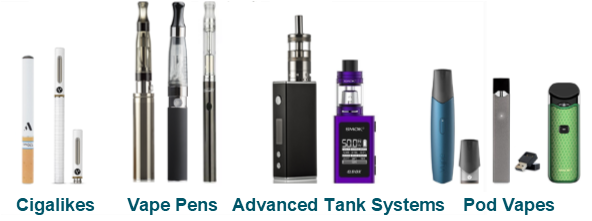Download the fact sheets:
- Upper Grand District School Board (PDF, 2 Pages, 147 KB)
- Wellington Catholic District School Board (PDF, 2 Pages, 147 KB)
What is an e-cigarette?
An e-cigarette is a battery-operated device that changes a liquid chemical (e-juice) into an aerosol that can be inhaled. This is often called vaping. E-cigarettes are also known as e-cigs, e-hookahs, vapes, vape pens, mods and tank systems. E-cigarettes come in many shapes and sizes. Some are made to look like regular cigarettes, cigars or pipes (i.e., cigalikes). Others resemble everyday items such as pens and USB sticks (i.e., vape pens and pod vapes). Advance tank systems are larger box-like or tubular devices. E-cigarette products can also be used to deliver cannabis and other drugs.

How common are e-cigarettes?
E-cigarette use among youth and young adults is increasing. In Wellington-Dufferin-Guelph, 20% of grade 7 and 10 students reported using an e-cigarette in the past year. Grade 10 students were more likely to report using an e-cigarette (39%) than grade 7 students (4%).
Pod vapes are becoming increasingly popular among youth. This is a concern as these products have high concentrations of nicotine and appealing product designs.
JUUL is a popular pod vape that resembles a USB. JUUL pods contain high levels of nicotine (1 pod = nicotine content of a pack of cigarettes) and the size/look of the device can easily be used and hidden in classrooms because they emit little aerosol.
E-cigarettes are marketed to youth by promoting fruit and candy e-juice flavours and colourful design and packaging.
Are e-cigarettes safe?
The long-term health effects of vaping are unknown as e-cigarettes are still fairly new products. The immediate health effects of vaping include: light-headedness, eye and throat irritation, headaches, dizziness and coughing.
E-cigarettes containing nicotine are unsafe for youth because the brain is still developing, making youth more vulnerable to nicotine addiction. Nicotine use at a young age can make it harder to learn, concentrate or control impulses.
Besides nicotine, e-juice can contain other harmful ingredients, including:
- Tiny particles that can be inhaled deep into the lungs and increase the risk of heart disease, lung cancer, asthma attacks and interfere with lung function
- Heavy metals (e.g., lead, mercury, nickel, copper) that can result in a variety of negative health effects (e.g., brain damage and cancer)
- Chemicals (e.g., diacetyl) in e-juice flavouring that can damage the lungs when they are inhaled
E-cigarette aerosol contains fewer toxic chemicals compared to cigarette smoke. However, e-cigarette aerosol still contains harmful substances and is therefore not harmless.
Youth who use e-cigarettes are more likely to smoke tobacco cigarettes.
If you don’t smoke, don’t vape.
Can e-cigarettes help you quit smoking?
E-cigarettes are not proven to help people quit smoking. Most smokers who try e-cigarettes do not quit smoking and they are more likely to co-use e-cigarettes and tobacco cigarettes or to switch to e-cigarettes for a short period and then go back to smoking tobacco cigarettes.
Are e-cigarettes legal?
In Canada, the sale of e-juice containing nicotine became legal in Canada in May 2018.
In Ontario, the sale and supply of e-cigarettes to anyone under 19 is prohibited. Also, the smoking of tobacco and cannabis, as well as vaping, is not allowed in many areas. Some include:
- Enclosed public places
- Enclosed workplaces
- Primary and secondary schools and their grounds
- Public areas within 20 metres from the perimeter of the grounds of primary and secondary schools
What is the school board’s policy on e-cigarettes?
It is the policy of the Upper Grand District School Board and Wellington Catholic District School Board to provide a smoke-free environment for its students, staff and others while on School Board property. E-cigarettes are included in this policy.
For more information visit: www.canada.ca/vaping
For help to quit vaping talk to your health care provider.
This information has been adapted with permission from Niagara Region Public Health.
